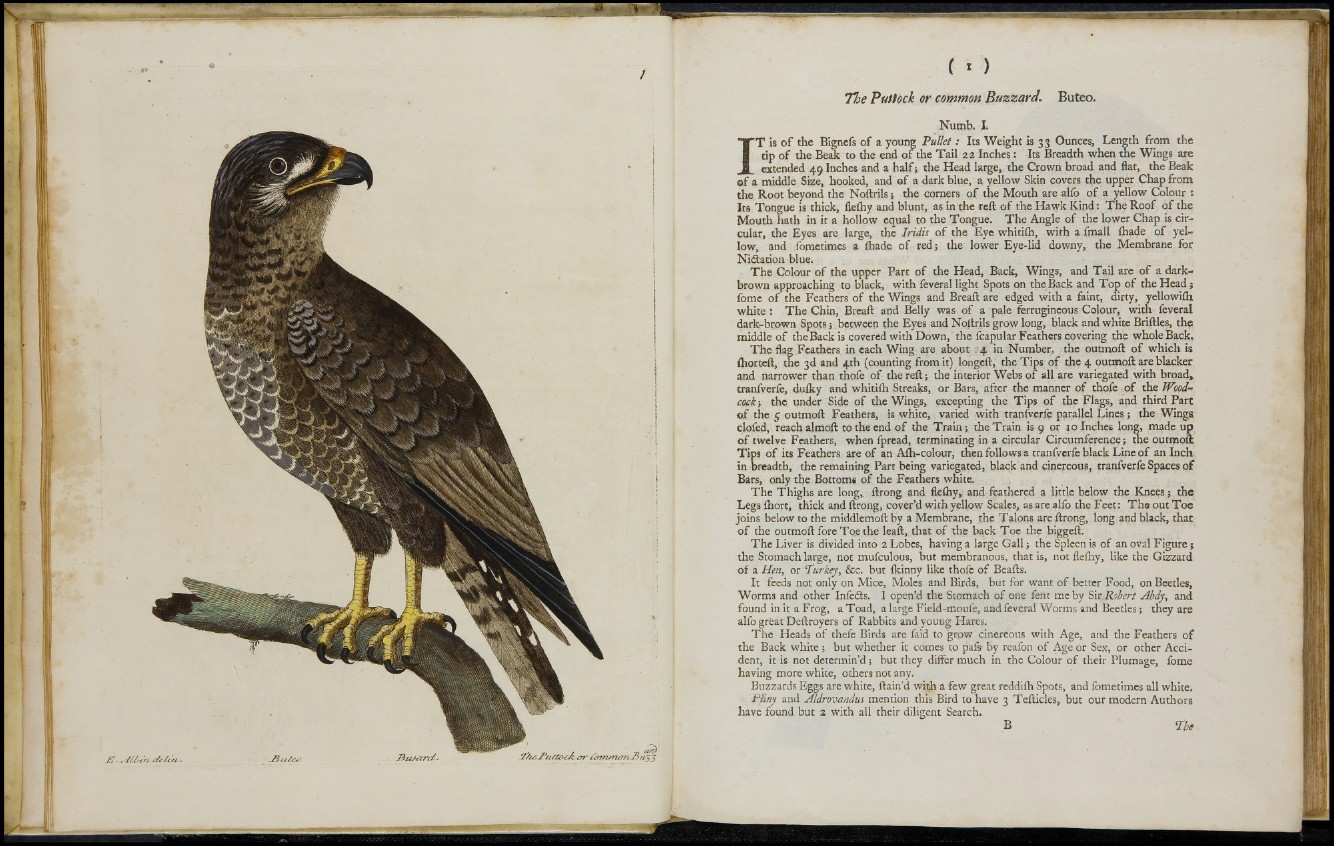
The Putiock or common Buzzard. Buteo.
Numb. I.
IT is o f the Bignefs of a young P u llet: Its Weight is 33 Ounces, Length from the
tip of the Beak to the end of the Tail 22 Inches: Its Breadth when the Wings are
extended 49 Inches and a half ; the Head large, the Crown broad and flat, the Beak
of a middle Size, hooked, and of a dark blue, a yellow Skin covers the upper Chap from
the Root beyond the Noftrils ; the corners of the Mouth are alio of a yellow Colour :
Its Tongue is thick, fleihy and blunt, as in the reft of the Hawk Kind: The Roof of the
Mouth hath in it a hollow equal to the Tongue. The Angle of the lower Chap is circular,
the Eyes are large, the Iridis of the Eye whitiih, with a fmall ihade of yellow,
and fotnetimes a ihade of red; the lower Eye-lid downy, the Membrane for
Ni&ation blue.
The Colour of the upper Part of the Head, Back, Wings, and Tail are of a dark-
brown approaching to black, with feveral light Spots on the Back and Top of the Head;
fome of the Feathers of the Wings and Breaft are edged with a faint, dirty, yellowiih
white : The Chin, Breaft and Belly was of a pale ferrugineous Colour, with feveral
dark-brown Spots; between the Eyes and Noftrils grow long, black and white Briftles, the
middle of the Back is covered with Down, the fcapular Feathers covering the whole Back.
The flag Feathers in each Wing are about 24 in Number, the outmoft of which is
ihorteft, the 3d and 4th (counting from it) longeft, the Tips of the 4 outmoft are blacker
and narrower than thole of the reft; the interior Webs of all are variegated with broad,
tranfverle, dulky and whitiih Streaks, or Bars, after the manner of thofeof the Woodcock;
the under Side of the Wings, excepting the Tips of the Flags, and third Part
o f the 5 outmoft Feathers,, is white, varied with tranfverle parallel Lines; the Wings
doled, reach almoft to the end o f the Train; the Train is 9 or 10 Inches long, made up
of twelve Feathers, when lpread, terminating in a circular Circumference; the outmoft
Tips of its Feathers are of an Aih-colour, then follows a tranfverfe black Line of an Inch
in breadth, the remaining Part being variegated, black and cinereous, tranfverfe Spaces of
Bars, only the Bottoms of the Feathers white.
The Thighs are long,, ftrong and flefliy,, and feathered a little below the Knees; the
Legs ihort, thick and ftrong, cover’d with yellow Scales, as are alfo the Feet: The out Toe
joins below to the middlemoft by a Membrane, the Talons are ftrong, long and black, that
of the outmoft fore To,e the leaft, that of the back Toe the biggeft.
The Liver is divided into 2 Lobes, having a large Gall; the Spleen is of an oval Figure;
the Stomach large, not mufculous, but membranous, that is, not fleihy, like the Gizzard
of a Hen, or Turkey, &c. but ikinny like thofe of Beafts.
It feeds not only on Mice, Moles and Birds, but for want of better Food, on Beetles,
Worms and other Infedts. I open’d the Stomach of one fent me by Sir.Robert Abdy, and
found in it a Frog, a Toad, a large Field-moufe, and feveral Worms and Beetles; they arc
allb great Deftroyers of Rabbits and young Hares.
The Heads of thefe Birds are faid to grow cinereous with Age, and the Feathers of
the Back white; but whether it comes to pals by realon of Age or Sex, or other Accident,
it is not determin’d ; but they differ much in the Colour of their Plumage, lome
having more white, others not any.
Buzzards Eggs are white, ftain’d with a few great reddilh Spots, and lometimes all white.
Pliny and Aldrovandus mention this Bird to have 3 Tefticles, but our modern Authors
have found but 2 with all their diligent Search.